Unit 6 When was it invented? Section A 3a -3c 课件(共23张PPT,无音频)2023-2024学年人教版九年级英语全册
文档属性
| 名称 | Unit 6 When was it invented? Section A 3a -3c 课件(共23张PPT,无音频)2023-2024学年人教版九年级英语全册 |  | |
| 格式 | pptx | ||
| 文件大小 | 2.0MB | ||
| 资源类型 | 教案 | ||
| 版本资源 | 人教新目标(Go for it)版 | ||
| 科目 | 英语 | ||
| 更新时间 | 2023-09-27 14:21:42 | ||
图片预览

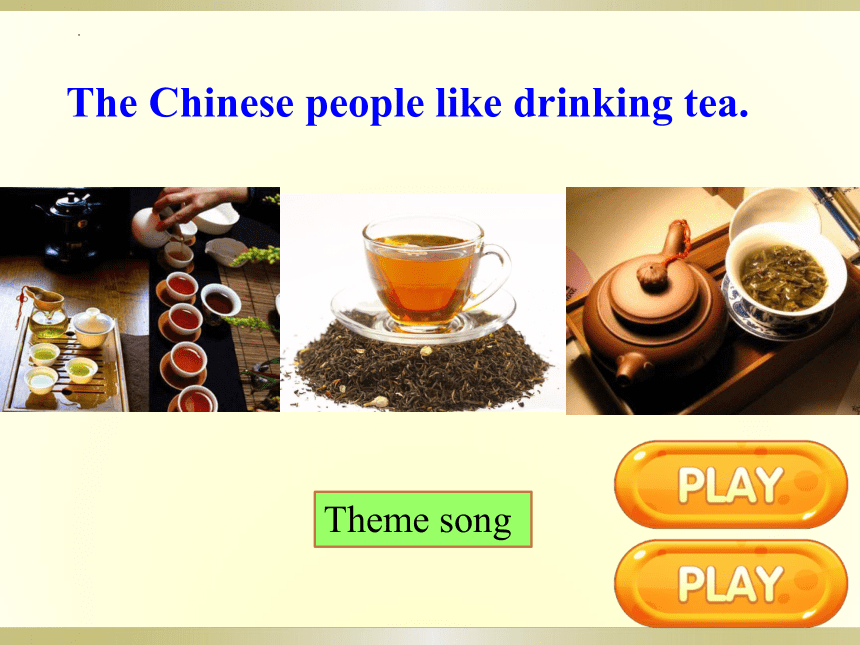
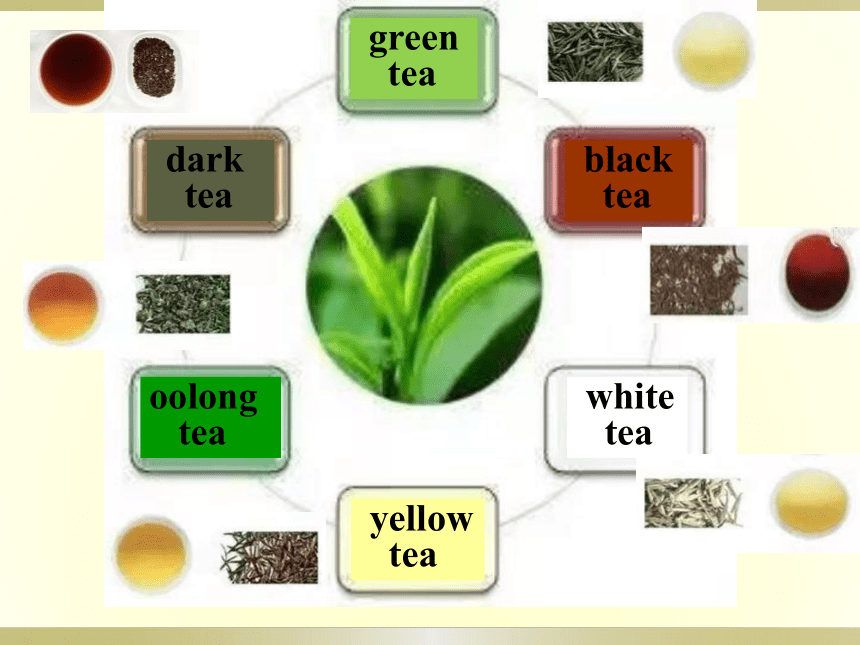

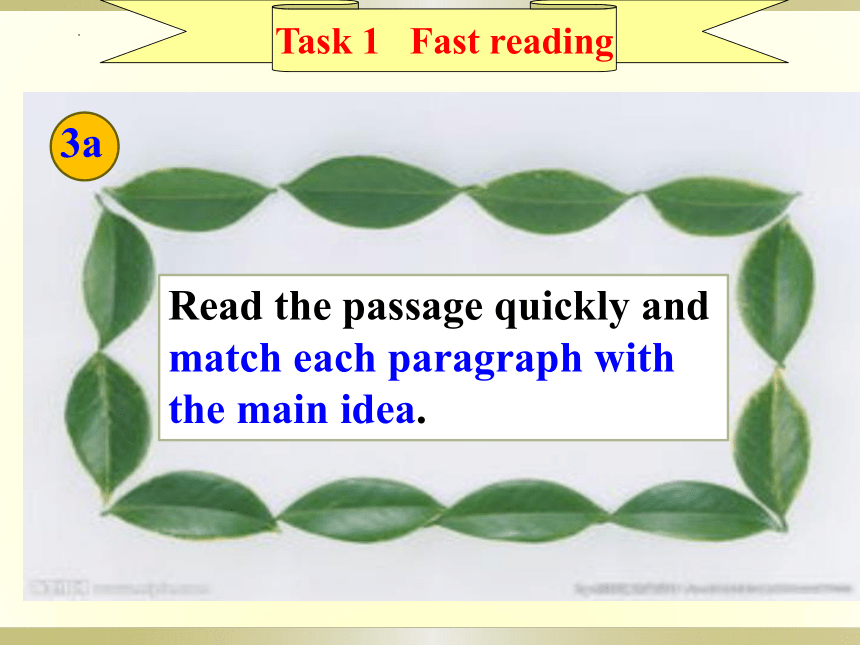

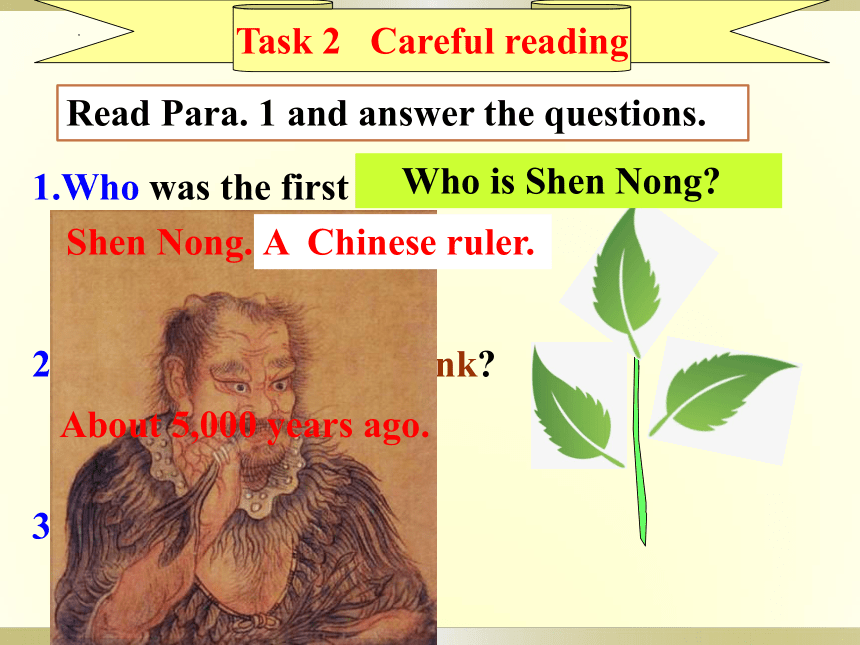
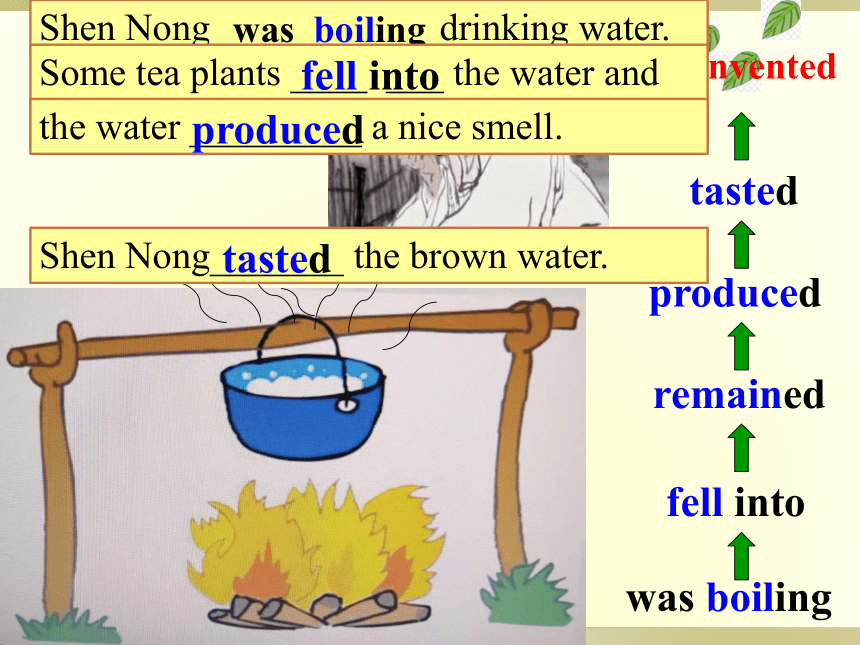
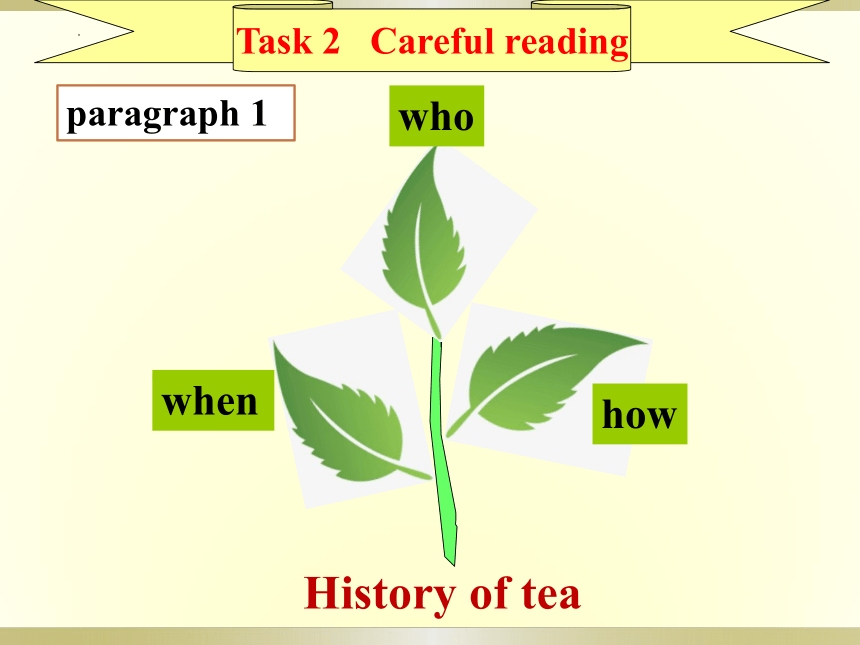
文档简介
(共23张PPT)
Do you like drinking tea
How many kinds of tea do you know
Do you know when the tea was invented
Free Talk
Unit 6 When was it invented
Section A (3a-3c)
The Chinese people like drinking tea.
Theme song
green
tea
black
tea
white
tea
yellow
tea
oolong
tea
dark
tea
An Accidental Invention
1.What is the invention
2.How was tea invented
Reading strategy: prediction
Pay attention to the title and the picture.
Tea .
Tea was invented by accident.
Task 1 Fast reading
3a
Read the passage quickly and match each paragraph with the main idea.
Lu Yu and his book Cha Jing
How tea spread to other countries
How tea was invented by accident
para1
para2
para3
Reading strategy: search for the key words/sentences
(the first sentence or the last sentence of each paragraph)
Task 2 Careful reading
Read Para. 1 and answer the questions.
1.Who was the first to discover tea
2.When was tea first drunk
3.How was tea invented
Shen Nong.
Who is Shen Nong
A Chinese ruler.
About 5,000 years ago.
was boiling
fell into
remained
produced
tasted
One of the world’s favourite drink was invented
Shen Nong ____ ______ drinking water.
was boiling
Some tea plants ____ ___ the water and
_________ there for some time.
fell into
remained
the water _________ a nice smell.
produced
Shen Nong_______ the brown water.
tasted
Task 2 Careful reading
paragraph 1
History of tea
who
when
how
Task 2 Careful reading
Read Para. 2 and fill in the blanks.
the saint of tea
圣人,圣徒
Lu Yu
目录 (Content)
茶之源
(be invented)
2.茶之造
(be grown and made)
3.茶之煮
(be produced)
……
It mentioned ____________.
It describes _____________
_______________________
_________.
It discusses _____________
_______________________
_______________________
__________.
◆
◆
◆
Shen Nong
how tea plants
were grown and used to make tea
where the finest
tea leaves were produced and what kinds of water
were used
Tip:Past passive voice
(be done)
development of tea
Task 2 Careful reading
Read Para.3 and choose the best answer.
Tea was brought to Korea and Japan ___.
A. during the 5th and 6th centuries
B. during the 6th and 7th centuries
C. during the 7th and 8th centuries
2. In England, tea didn’t appear until about __.
A. 1616 B. 1660 C. 1661
3. The tea trade from China to Western
countries took place _______.
in the 17th century B. in the 18th century
C. in the 19th century
Western countries
Western countries
Korea and Japan
During the 6th and 7th centuries
England
Around 1660
Western countries
In the 19th century
Read paragraph 3 and tell how tea became popular
popularity of tea
Reading Strategy : Knowing the part of speech (词性) can help us understand the meaning better.
Why the Chinese are without doubt the ones who best understand the nature of tea
Group discussion
Chinese
Chinese
Chinese
history
development
popularity
It’s our duty to
spread tea culture
Summary
The school is having an interview about Chinese tea on TV. Two students work in a pair, one is the host or hostess (主持人), the other is a guests (嘉宾).
An interview
Pairwork
1.Who was the first to discover tea 4.What is Cha Jing about
2.How was tea invented 5.What countries was tea brought to
3.Who is called “the saint of tea”
Host: Welcome to China Talk. Today we invite a guest to
talk about Chinese Tea. Can you tell us who was the
first to discover tea
A: Shen Nong .
Host: ……
Host: Thank you and thanks for your listening, see you.
Language points
1.Some leaves from a tea plant fell into the water and remained there for some time.
一些茶树上的叶子落到了水里,并且在里面煮了一段时间。
【解读】remain 意为“逗留;留下”,相当于stay. 注意remain还有“保持某种状态;继续存在;仍旧是”的意思,后面可以跟形容词、现在分词、介词短语等。remain只作不及物动词,而keep 可以作及物动词。remain 作为名词,意为“剩余物;遗体;遗迹”, remains of the meal剩余饭菜,one’s remain 某人的遗体,remains of a temple 寺庙遗迹。
【举例】(1)Whatever great progress you have made, you should remain modest.
无论你取得了多大进步,你都应该保持谦虚。
(2)She remained sitting when they came in. 他们进来时,她仍然坐着。
(3)This remains in my mind. = I keep this in my mind. 对此,我铭记在心。
【练习】用remain和keep的适当形式填空。
(1)He ________ in the hospital last month.
(2)Please ________ some water in the bottle.
(3)________ of the meal are not good for our health.
remained
keep
Remains
2.The tea trade from China to Western countries took place in the 19th century. 中国与西方各国之间的茶叶贸易出现于19世纪。
【解读】take place 意为“发生;出现”, 一般用于非偶然性事件的“发生”,指事件的发生一定有某种原因或事先安排;而happen 一般用于偶然或突发事件。
【举例】(1)I happened to sit by her in the cinema. 在电影院我碰巧坐在她旁边。
(2)I can’t remember what happened then.那时发生了什么我记不起来了。
(3)The Olympic Games of 2008 took place in Beijing.2008年奥运会在北京举办。
【练习】用happen和take place的适当形式填空。
(1)Great changes have ________ in this area since 1982.
(2)The story of Tom Sawyer ________in Missouri, America, in the 19th century.
(3)The Olympic Games of 2016 will ________ in Brazil.
taken place
happened
take place
3. It produced a nice smell so he tasted the brown water anyway. 水中散发出一种很香的味道,因此他尝了尝那棕色的汤水。
【解读】smell在本句中为名词,意思为“气味”,它也可作系动词,意为“闻起来;发出……气味”,后跟形容词作表语。它作动词时意思为“闻到, 嗅到”。
【举例】(1)The smell from the kitchen made my mouth water.
厨房里飘来的香味使我垂涎。
(2)These flowers smell very sweet. 这些花闻起来很香。
(3)As soon as we opened the front door, we could smell the gas.
我们一打开前门就闻到了煤气的味道。
【练习】
(1)The meat is producing a terrible s________. Throw it away.
(2) I like to read English in the garden because the flowers in it smell ______.
A. good B. well C. bad D. badly
mell
A
一、Fill in the blanks.
1.This helped _________ (spread) the popularity of tea plant to more places around the world.
2.Even though many people now know about tea culture, the Chinese are ______________the ones who best understand the nature of tea.
to spread
without doubt
二、Translation
1.直到1610年茶才被带到西方世界。
2. 这个机器是用来烧开水的。
3. 我已好久没见我奶奶,我十分想念她。
Tea wasn’t brought to the Western world until 1610.
This machine is used for boiling drinking water.
I haven’t seen my grandmother for some time. I miss her very much.
随堂检测
Summary
重点词组:1.by accident 2. take place 3.without doubt
4.fall into 5.It is believed that 6.even though
重点句型:
1.He was asked to think of a game that could be played in the winter.
2.Basketball has not only become a popular sport to play, but it has also become a popular sport to watch.
3.The number of foreign players, including Chinese players, in the NBA has increased.
重点语法:not only...but also...; the number of...的用法
Do you like drinking tea
How many kinds of tea do you know
Do you know when the tea was invented
Free Talk
Unit 6 When was it invented
Section A (3a-3c)
The Chinese people like drinking tea.
Theme song
green
tea
black
tea
white
tea
yellow
tea
oolong
tea
dark
tea
An Accidental Invention
1.What is the invention
2.How was tea invented
Reading strategy: prediction
Pay attention to the title and the picture.
Tea .
Tea was invented by accident.
Task 1 Fast reading
3a
Read the passage quickly and match each paragraph with the main idea.
Lu Yu and his book Cha Jing
How tea spread to other countries
How tea was invented by accident
para1
para2
para3
Reading strategy: search for the key words/sentences
(the first sentence or the last sentence of each paragraph)
Task 2 Careful reading
Read Para. 1 and answer the questions.
1.Who was the first to discover tea
2.When was tea first drunk
3.How was tea invented
Shen Nong.
Who is Shen Nong
A Chinese ruler.
About 5,000 years ago.
was boiling
fell into
remained
produced
tasted
One of the world’s favourite drink was invented
Shen Nong ____ ______ drinking water.
was boiling
Some tea plants ____ ___ the water and
_________ there for some time.
fell into
remained
the water _________ a nice smell.
produced
Shen Nong_______ the brown water.
tasted
Task 2 Careful reading
paragraph 1
History of tea
who
when
how
Task 2 Careful reading
Read Para. 2 and fill in the blanks.
the saint of tea
圣人,圣徒
Lu Yu
目录 (Content)
茶之源
(be invented)
2.茶之造
(be grown and made)
3.茶之煮
(be produced)
……
It mentioned ____________.
It describes _____________
_______________________
_________.
It discusses _____________
_______________________
_______________________
__________.
◆
◆
◆
Shen Nong
how tea plants
were grown and used to make tea
where the finest
tea leaves were produced and what kinds of water
were used
Tip:Past passive voice
(be done)
development of tea
Task 2 Careful reading
Read Para.3 and choose the best answer.
Tea was brought to Korea and Japan ___.
A. during the 5th and 6th centuries
B. during the 6th and 7th centuries
C. during the 7th and 8th centuries
2. In England, tea didn’t appear until about __.
A. 1616 B. 1660 C. 1661
3. The tea trade from China to Western
countries took place _______.
in the 17th century B. in the 18th century
C. in the 19th century
Western countries
Western countries
Korea and Japan
During the 6th and 7th centuries
England
Around 1660
Western countries
In the 19th century
Read paragraph 3 and tell how tea became popular
popularity of tea
Reading Strategy : Knowing the part of speech (词性) can help us understand the meaning better.
Why the Chinese are without doubt the ones who best understand the nature of tea
Group discussion
Chinese
Chinese
Chinese
history
development
popularity
It’s our duty to
spread tea culture
Summary
The school is having an interview about Chinese tea on TV. Two students work in a pair, one is the host or hostess (主持人), the other is a guests (嘉宾).
An interview
Pairwork
1.Who was the first to discover tea 4.What is Cha Jing about
2.How was tea invented 5.What countries was tea brought to
3.Who is called “the saint of tea”
Host: Welcome to China Talk. Today we invite a guest to
talk about Chinese Tea. Can you tell us who was the
first to discover tea
A: Shen Nong .
Host: ……
Host: Thank you and thanks for your listening, see you.
Language points
1.Some leaves from a tea plant fell into the water and remained there for some time.
一些茶树上的叶子落到了水里,并且在里面煮了一段时间。
【解读】remain 意为“逗留;留下”,相当于stay. 注意remain还有“保持某种状态;继续存在;仍旧是”的意思,后面可以跟形容词、现在分词、介词短语等。remain只作不及物动词,而keep 可以作及物动词。remain 作为名词,意为“剩余物;遗体;遗迹”, remains of the meal剩余饭菜,one’s remain 某人的遗体,remains of a temple 寺庙遗迹。
【举例】(1)Whatever great progress you have made, you should remain modest.
无论你取得了多大进步,你都应该保持谦虚。
(2)She remained sitting when they came in. 他们进来时,她仍然坐着。
(3)This remains in my mind. = I keep this in my mind. 对此,我铭记在心。
【练习】用remain和keep的适当形式填空。
(1)He ________ in the hospital last month.
(2)Please ________ some water in the bottle.
(3)________ of the meal are not good for our health.
remained
keep
Remains
2.The tea trade from China to Western countries took place in the 19th century. 中国与西方各国之间的茶叶贸易出现于19世纪。
【解读】take place 意为“发生;出现”, 一般用于非偶然性事件的“发生”,指事件的发生一定有某种原因或事先安排;而happen 一般用于偶然或突发事件。
【举例】(1)I happened to sit by her in the cinema. 在电影院我碰巧坐在她旁边。
(2)I can’t remember what happened then.那时发生了什么我记不起来了。
(3)The Olympic Games of 2008 took place in Beijing.2008年奥运会在北京举办。
【练习】用happen和take place的适当形式填空。
(1)Great changes have ________ in this area since 1982.
(2)The story of Tom Sawyer ________in Missouri, America, in the 19th century.
(3)The Olympic Games of 2016 will ________ in Brazil.
taken place
happened
take place
3. It produced a nice smell so he tasted the brown water anyway. 水中散发出一种很香的味道,因此他尝了尝那棕色的汤水。
【解读】smell在本句中为名词,意思为“气味”,它也可作系动词,意为“闻起来;发出……气味”,后跟形容词作表语。它作动词时意思为“闻到, 嗅到”。
【举例】(1)The smell from the kitchen made my mouth water.
厨房里飘来的香味使我垂涎。
(2)These flowers smell very sweet. 这些花闻起来很香。
(3)As soon as we opened the front door, we could smell the gas.
我们一打开前门就闻到了煤气的味道。
【练习】
(1)The meat is producing a terrible s________. Throw it away.
(2) I like to read English in the garden because the flowers in it smell ______.
A. good B. well C. bad D. badly
mell
A
一、Fill in the blanks.
1.This helped _________ (spread) the popularity of tea plant to more places around the world.
2.Even though many people now know about tea culture, the Chinese are ______________the ones who best understand the nature of tea.
to spread
without doubt
二、Translation
1.直到1610年茶才被带到西方世界。
2. 这个机器是用来烧开水的。
3. 我已好久没见我奶奶,我十分想念她。
Tea wasn’t brought to the Western world until 1610.
This machine is used for boiling drinking water.
I haven’t seen my grandmother for some time. I miss her very much.
随堂检测
Summary
重点词组:1.by accident 2. take place 3.without doubt
4.fall into 5.It is believed that 6.even though
重点句型:
1.He was asked to think of a game that could be played in the winter.
2.Basketball has not only become a popular sport to play, but it has also become a popular sport to watch.
3.The number of foreign players, including Chinese players, in the NBA has increased.
重点语法:not only...but also...; the number of...的用法
同课章节目录
- Unit 1 How can we become good learners.
- Section A
- Section B
- Unit 2 I think that mooncakes are delicious!
- Section A
- Section B
- Unit 3 Could you please tell me where the restroom
- Section A
- Section B
- Unit 4 I used to be afraid of the dark.
- Section A
- Section B
- Unit 5 What are the shirts made of?
- Section A
- Section B
- Review of Units 1-5
- Unit 6 When was it invented?
- Section A
- Section B
- Unit 7 Teenagers should be allowed to choose their
- Section A
- Section B
- Unit 8 It must belong to Carla.
- Section A
- Section B
- Unit 9 I like music that I can dance to.
- Section A
- Section B
- Unit 10 You're supposed to shake hands.
- Section A
- Section B
- Review of Units 6-10
- Unit 11 Sad movies make me cry.
- Section A
- Section B
- Unit 12 Life is full of the unexpected
- Section A
- Section B
- Unit 13 We're trying to save the earth!
- Section A
- Section B
- Unit 14 I remember meeting all of you in Grade 7.
- Section A
- Section B
- Review of Units 11-14
